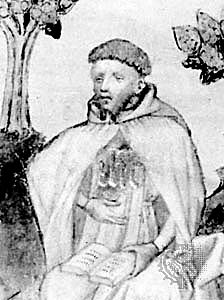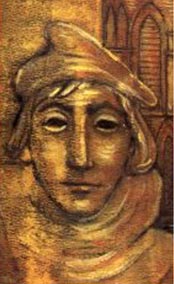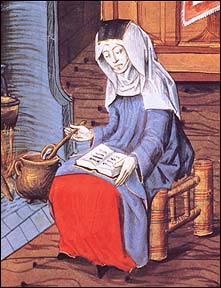Readings:
Job 26:1-14
Psalm 63:1-8
Romans 11:33–36
Mark 4:35-41Preface of a Saint (3)
[Common of a Theologian and Teacher]
[Of the Incarnation]
PRAYER (traditional language)
Direct our hearts, O Gracious God, and inspire our minds, that like thy servants Richard Rolle, Walter Hilton, and Margery Kempe, we might pass through the cloud of unknowing until we behold thy glory face to face; in the Name of Jesus Christ our Lord; who with thee and the Holy Ghost liveth and reigneth, one God, world without end. Amen.
PRAYER (contemporary language)
Direct our hearts, O Gracious God, and inspire our minds, that like your servants Richard Rolle, Walter Hilton, and Margery Kempe, we might pass through the cloud of unknowing until we behold your glory face to face; in the Name of Jesus Christ our Lord; who with you and the Holy Spirit lives and reigns, one God, for ever and ever. Amen.
Lessons revised at General Cponvention 2024
Return to Lectionary Home Page
Webmaster: Charles Wohlers
Last updated: 7 Sept. 2024
RICHARD ROLLE, WALTER HILTON, AND MARGERY KEMPE
MYSTICS, 1349, 1396, c. 1440
 Richard
Rolle (1290–1349) was an English religious writer, Bible
translator, and hermit. He is known as Richard Rolle of Hampole or de
Hampole, since after years of wandering he settled in his final years
at Hampole, near the Cistercian nunnery.
Richard
Rolle (1290–1349) was an English religious writer, Bible
translator, and hermit. He is known as Richard Rolle of Hampole or de
Hampole, since after years of wandering he settled in his final years
at Hampole, near the Cistercian nunnery.
He wrote in both Latin and English (his first work, Melum, was of alliterative Latin); many works are attributed to him, but it has been questioned how many are genuinely from his hand.
In one of his best-known works, The Fire of Love, Rolle provides an account of his mystical experiences, which he describes as being of three kinds: a physical warmth in his body, a sense of wonderful sweetness, and a heavenly music that accompanied him as he chanted the Psalms. The book was widely read in the Middle Ages, and described the four purgative stages that one had to go through to become closer to God: described as open door, heat, song, and sweetness. Because of the wide proliferation of his works, there was a movement to have him canonized. As many of his works were concerned with personal devotion, some, with considerable alterations, were used by the Lollards.
— more from Wikipedia
 Walter Hilton (1340 – 24 March 1396) was an English
Augustinian mystic.
Walter Hilton (1340 – 24 March 1396) was an English
Augustinian mystic.
Little is known of his life. He was the head of a house of Augustinian Canons at Thurgarton Priory, near Newark, in Nottinghamshire. He was closely in touch with the Carthusians, though not a member of that order.
His spiritual writings were widely influential during the fifteenth century in England. The most famous of these is the Scala Perfectionis, or Ladder of Perfection, in two books, first printed by Wynkyn de Worde in 1494. This work may be described as a guide-book for the journey to the spiritual Jerusalem, which is "contemplation in perfect love of God". The soul is reformed to the image and likeness of God, first in faith only, and then in faith and in feeling. Speeded by humility and love, it passes through the mystical dark night, which "is nought else but a forbearing and a withdrawing of the thought and of the soul from earthly things by great desire and yearning for to love and see and feel Jesus and spiritual things". By the gift of love all the vices are destroyed, and the soul at length becomes a perfect lover of Jesus, "fully united to Him with softness of love". His presence is the life of the soul, even as the soul is the life of the body. Purified to know His secret voice, its spiritual eyes are opened to see His workings in all things and to behold His blessed nature. Hilton's mystical system is, in the main, a simplification of that of Richard of St. Victor, and, like Richard, he humbly disclaims any personal experience of the Divine familiarity which he describes, declaring that he has not the grace of contemplation himself "in feeling and in working, as I have it in talking".
— more from Wikipedia
 Margery Kempe (c. 1373 – after 1438) is known
for writing The
Book of Margery Kempe, a work considered by some to be the first
autobiography in the English language. This book chronicles, to some extent,
her extensive pilgrimages to various holy sites in Europe and Asia.
Margery Kempe (c. 1373 – after 1438) is known
for writing The
Book of Margery Kempe, a work considered by some to be the first
autobiography in the English language. This book chronicles, to some extent,
her extensive pilgrimages to various holy sites in Europe and Asia.
Part of Margery Kempe's significance lies in the autobiographical nature of her book: it is the best insight available that points to a female, middle class experience in the Middle Ages. Kempe is admittedly unusual among the more traditional holy exemplars of her time, such as Julian of Norwich. Margery, in fact, described her visit to Julian in her anchorhold in Norwich, and describes how they together discussed Margery's visions as to their orthodoxy, deciding that because they lead to charity they were of the Holy Spirit.
Though Kempe is often depicted as an "oddity" or even a "madwoman," recent scholarship on vernacular theologies and popular practices of piety suggest she was not, perhaps, as odd as she appears. Rather than being the ramblings of a madwoman, her Book is revealed as a carefully constructed spiritual and social commentary. ... Her autobiography begins with "the onset of her spiritual quest, her recovery from the ghostly aftermath of her first child-bearing". There is no firm evidence that Margery Kempe could herself read or write, but Leyser notes how religious culture was informed by texts, as was that of her more well-known contemporary Julian of Norwich, noting how there is some evidence that the "Incendium Amoris" by Richard Rolle influenced Margery Kempe; Walter Hilton has been cited as another possible influence on Kempe. Among other books that Margery had read to her were, repeatedly, the "Revelationes" of Birgitta of Sweden and, in fact, her pilgrimages carefully copy those of that married saint who had had eight children.
— more from Wikipedia